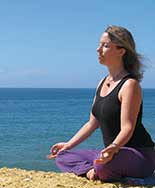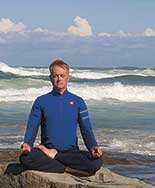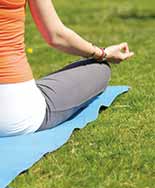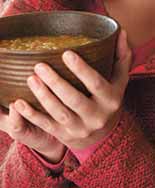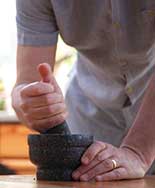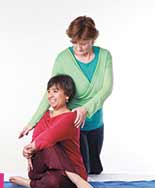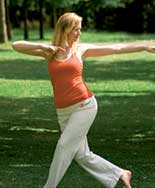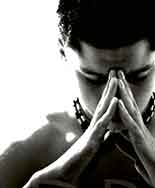I always experience an upsurge of joy when I see signs of spring, especially after a harsh winter. I’ve been asking myself how to actively increase that feeling of happiness even when life is challenging or when it’s raining.
According to recent research, meditation seems to be an answer, as it seems to be the only activity which resets the brain’s happiness set point. As a meditation teacher trainer and psychology graduate, my ears always prick up when I hear that we can change our minds in relatively simple ways.
According to neuroscientists, we all have a natural set point for happiness, based on our genes and conditioning. Although we may feel temporary joy or sadness from a change of circumstances, we will keep returning to our baseline happiness level or set point. This is the exciting part – new studies show that we can train our brains to be happier and change this happiness set point. One effective way to do this is through meditation. (Davidson et al 2004)
What is Dru Meditation?
I like to define meditation at the perfect balance between alertness and relaxation. It doesn't matter if you practise in a chair or sitting cross legged on the floor, it's all about quietening the mind and stilling the body. Dru Meditation, in common with many other types of meditation, starts with this gentle awareness of the body and breath. This mindful awareness is the first stage of meditation, where we accept the body as it is, and keep our awareness on the body or the breath, using a wide range of techniques.
Mindful awareness of this nature is used in many types of meditation, and it has huge health benefits as many studies have shown. Awareness- based meditation reduces stress and so when practised regularly lowers blood pressure, insomnia and chronic pain and also reduces the risk of heart disease and cancer . So even the first stage of Dru meditation - just sitting still, being aware of your body and breath flowing in and out, has a profound effect on your health and wellbeing!
How is Dru Meditation different?
But this is where Dru meditation goes a bit deeper. Rather than just accepting the body and mind as they are, we want to understand the vast landscape of our consciousness. As Dru comes from a yogic tradition, we seek to understand our mind based on that rich experience - so we describe our consciousness in terms of chakras (seven energy centres in the spine) and the koshas (five layers of our awareness, from the most gross to the most subtle).
So in the second stage of Dru Meditation, we take mindful awareness to a whole new level. We now effortlessly take our attention to these more refined aspects of our awareness. Doing this helps us experience first-hand how our body, energy, emotions and thoughts are all linked together. And just as mindful awareness of our physical body and breath has immense healing benefits, taking our attention to a mindful awareness of these more subtle experiences creates immense healing potential in our energy system, our emotions and out thoughts.
The third stage of Dru meditation, which you will experience on the Dru Meditation Training course, will teach you how to transform your consciousness. You'll learn not only how to understand your mind, but how to change it. You'll learn how you can become the master of your emotions, not the victim. You'll learn powerful meditation techniques including kriyas and breathing techniques which will empower your inner strengths and give you the inner resources to change your habits for the better. You'll gain a deep understanding of the radiant nature of your Highest Self, which is beyond limitations and pain.
I have experienced at first-hand how meditation has a positive effect on the mood of my students. Over the last 12 years of teaching meditation, I've heard time and time again that my students feel more upbeat and positive after starting a regular meditation practice.
Benefits of the Dru Meditation course
Michael from Switzerland said, 'The Dru meditation course gave me techniques to stay joyful, happy and positive throughout the day. It helped me develop my personality, making me more successful in my job and my relationship.'
Hilary from the West Midlands reported that 'this course has opened me to an endless flowing waterfall of loving emotion, peace and joy.'
And it's not just a temporary effect. In fact, other research has demonstrated that meditators' brains structurally change with practice. Researchers in Kyoto identified an area in the brain called the precuneus which was larger in people who were happier. Previous research has shown that people who meditate regularly can increase the grey matter in the precuneus. Other changes in the brains of meditators reveal an increase in the areas of the brain associated with attention, compassion and emotional intelligence - suggesting that meditators are actually re-wiring their brains to be happier! (Lazar et al 2011).
Three meditation tools for happiness
- Cultivate acceptance
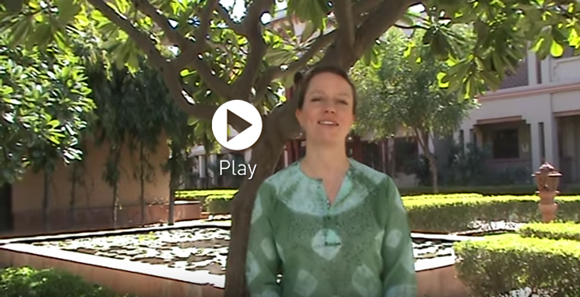 This is the first technique we teach on meditation retreats - the ability to accept what we can't change, courage to change the things we can, and the wisdom to know the difference. Sounds familiar? It certainly works and can eliminate a lot of suffering from our lives. Watch a video of my acceptance meditation here.
This is the first technique we teach on meditation retreats - the ability to accept what we can't change, courage to change the things we can, and the wisdom to know the difference. Sounds familiar? It certainly works and can eliminate a lot of suffering from our lives. Watch a video of my acceptance meditation here.
- Call back your power
On the third module of the Dru Meditation training course, we teach a powerful technique to draw back any emotional energy which may be stuck in old relationships or painful memories. Letting go of the past is a powerful way to become content in the moment. Why not try this technique? Sitting comfortably, connect with the earth and your breath. Each time you inhale, imagine that you're drawing back to you any energy you've invested in the past. On each exhale, feel that energy being dispersed through your body, bringing nourishment and balance. Repeat for a few moments, then gently bring your awareness back to the present moment and open your eyes.
- Strengthen your Manomaya kosha
In the yoga model, each kosha or layer of our being has its own functions and benefits. The emotional layer, or manomaya kosha, can be strengthened and awakened through the practice of Dru meditation - and on the meditation course we teach you specific techniques to become the master of your emotions rather than the victim.
The simplest way to strengthen your manomaya kosha is to start believing in yourself.
So often we are critical of ourselves and others, so start by completely accepting yourself just as you are now. Start to accept your beautiful body, your mind and your emotions. Believe that you have so many unique talents and strengths that the world needs. Stand in your power and breathe into your greatness. As it says in the Desiderata, you are a child of the universe, no less than the trees and stars. You have a right to be here.
The five koshas
Dru Meditation draws on thousands of years of yogic wisdom to help you discover stillness, no matter how busy you are. Using powerful breathing techniques (pranayama), kriyas and concentration techniques, you will learn to focus your mind, release stress and access a deep sense of inner peace and happiness.
Dru takes you deeply into the science of meditation, showing how to bring your awareness from the physical body, through to the deepest layers of your being. Dru meditation uniquely makes a focus of the five koshas, which are the different levels through which we experience the world.
Dru Meditation and the five koshas (levels of consciousness)
1. Anamaya kosha (physical pody) using mindful awareness, you will learn to sit comfortably and relax at will, balancing the sympathetic and parasympathetic nervous systems so you remain alert yet relaxed.
2. Pranamaya kosha (energy body) powerful breathing techniques such as Sama vritti, the three fold breath and Savitri pranayma will enable you to build up your energy and health.
3. Manomaya kosha (emotional body) Dru's kriyas and meditation techniques will help you become the master of your emotions, enabling you to access passion and willpower so you can choose how you feel in any moment.
4. Vijnaanamaya kosha (intellectual body) Using the ancient power of mantra and japa, you will awaken your inner wisdom body, where intuition and your life's purpose become clear.
5. Anandamaya kosha (blissful body) using Dru's subtle meditation methods, you will experience the joy of your higher self, however you perceive it.
Want to try some Dru Meditation?
The Dru Meditation foundation course is a brilliant way to create an inspired home practice. If you're looking for a deeper practice of self- development or are interested in teaching, we recommend the Meditation teacher Training course. This next course starts in the Midlands in May, and Snowdonia or London in November.
Find out more here.
Dru Meditation is available both as an online course here, or the Dru Yoga online studio, which you can practise at home. If you'd like to come on a Meditation retreat in Snowdonia, we have a couple of places left - more information here.







